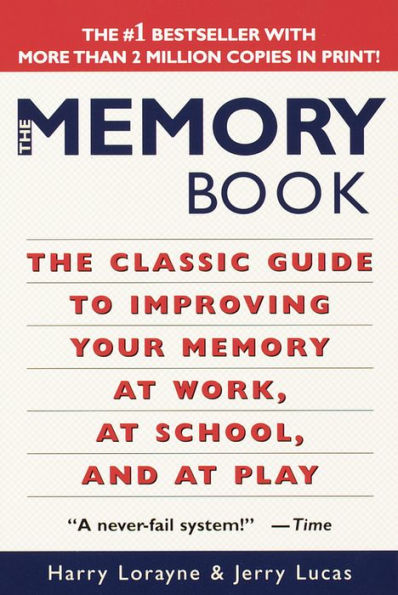Read an Excerpt
1 SOME HISTORY OF THE ART
Memory systems date back to antiquity. In the ancient world, a trained memory was of vital importance. There were no handy note-taking devices, and it was memory techniques and systems that enabled bards and storytellers to remember their stories, poems, and songs.
Early Greek and Roman orators delivered lengthy speeches with unfailing accuracy because they learned the speeches, thought for thought, by applying memory systems.
What they did, basically, was associate each thought of a speech to a part of their own homes. These were called “loci,” or “places.” The opening thought of a speech would, perhaps, be associated to the front door, the second thought to the foyer, the third to a piece of furniture in the foyer, and so on. When the orator wanted to remember his speech, thought for thought, he actually took a mental tour through his own home. Thinking of the front door reminded him of the first thought of his speech. The second “place,” the foyer, reminded him of the next thought; and so on to the end of the speech. It is from this “place” or “loci” memory technique that we get the time-worn phrase “in the first place.”
Although Simonides (circa 500 B.C.) is known as the father of the art of trained memory, scraps of parchment dating back a thousand years or so before Simonides state that memory techniques were an essential part of the orator’s equipment.
Cicero wrote that the memories of the lawyers and orators of his time were aided by systems and training and in De oratore he described how he himself applied memory systems.
It’s important to realize that oratory was an important career during those early days. “We should never have realized how great is the power [of a trained memory],” wrote the philosopher Quintilian, “nor how divine it is, but for the fact that it is memory which has brought oratory to its present position of glory.”
The ancients also knew that memory training could help the thinking process itself. From a fragment dated about 400 B.C. we learn that “A great and beautiful invention is memory, always useful both for learning and for life.” And Aristotle, after praising memory systems, said that “these habits too will make a man readier in reasoning.”
If Simonides was the inventor of the art of trained memory, and Cicero its greatest early teacher, St. Thomas Aquinas was to become its patron saint, instrumental in making the art of trained memory a devotional and ethical art.
During the Middle Ages, monks and philosophers were virtually the only people who knew about and applied trained-memory techniques. The systems, whose use was mostly limited to religion, were basic to some religions. For example, memory systems were used to memorize Virtues and Vices, and some priests and philosophers taught that memory systems showed “how to reach Heaven and avoid Hell.”
In 1491, Peter of Ravenna wrote The Phoenix, which became the best known of all early memory-training books and brought the art of trained memory out into the lay world. During the fifteenth and sixteenth centuries, many other books were written on the subject.
King Francis I of France used memory systems, as did England’s Henry III. Shakespeare is held to have used trained-memory systems—his Globe Theater was called the “memory theater.” Philosophers of the seventeenth century taught memory systems (Francis Bacon has one in his book The Advancement of Learning), and some scholars insist that Leibniz invented calculus while searching for a memory system that would aid in memorizing numbers.
So you see, there’s nothing really new about trained-memory techniques. Unfortunately, the techniques fell into disuse for centuries. Some people who did practice them were actually regarded as witches. It’s true that memory systems remained in use as a source of entertainment for others—in our own century, vaudeville players used memory systems to perform “mental tricks” onstage—but they were seldom if ever used for practical purposes or serious learning. Here and there someone would try to bring the systems to the fore again, but without success.
In a book titled Memory, William Stokes, a philosopher and memory teacher of the 1800’s, summarizes the degree of public interest in the art of trained memory:
It is true … that notwithstanding the records of the past and the achievements, triumphs, and trophies of the present, the “educated,” the intelligent masses—the world—know not and seem not to care to know its wondrous worth. The adoption of the science by a few paltry thousands cannot be regarded as anything when we consider the countless myriads peopling the earth—when we realize the fact that it is as essential to the proper exercise and full development of our intellectual existence as proper breathing is to our physical well-being; in spite of all that has been said and done, we may say comparatively—almost absolutely—that the art is a thing unknown!
There can be little doubt that before long, it will be generally recognized as an established science; and posterity will look back, and regard … this plea on behalf of memory … as an indication of the intellectual darkness of this age of boasted enlightenment.…
Let us hope that the day will come when it shall be considered as great a disgrace not to use memory systems as it is at present not to read!
Stokes’s book was published in 1888. Nearly a century later, it is our pleasure to bring the art of trained memory back into the foreground—not only by teaching memory systems, but by bringing them to a level that the ancient (and not-so-ancient) thinkers would never have conceived as being within the realm of possibility.



